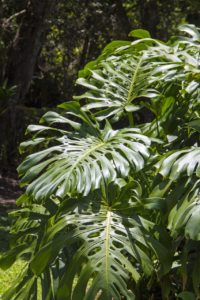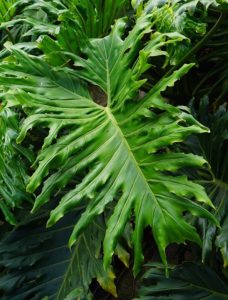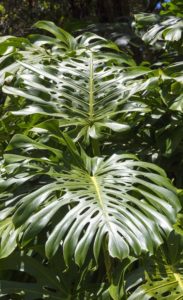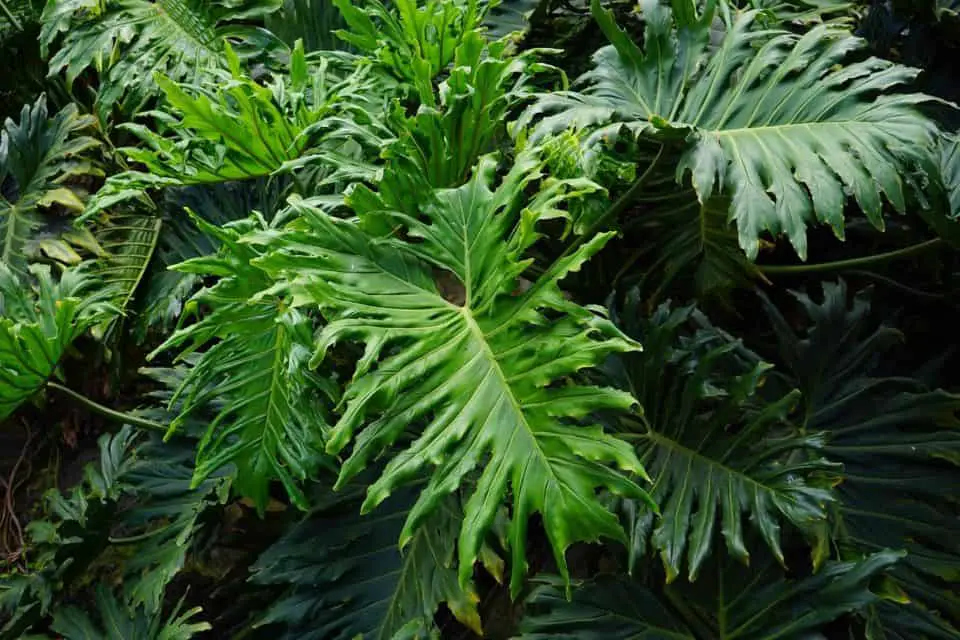Some links in the post are affiliate links and I get a commission from purchases made through some links found in the post.
Decorating your home, office, or other space helps you get the most out of it.
While you can always choose an art piece or opt to paint the room a bright hue, plants have proven to add a beautiful touch to any room.
They have a natural allure to them that livens up any room while serving as a centerpiece for your space.
Choosing what’s suitable for your home can be a bit challenging, but it’s hard to go wrong with philodendron selloum.
This species boasts of deeply lobed, glossy leaves. It also goes by the name tree philodendron because it can support its weight even at four feet.
Besides its undeniable beauty, it is also easy to care for and adapts to various growing conditions.
However, you may have some trouble getting it to thrive to an eye-catching point. This can be due to the common problems which are faced when growing this plant.
The common philodendron Selloum problems are; poor draining soil, bad lighting, overwatering or underwatering, temperature and humidity issues and fertilization problems.
These can lead to the leaves turning yellow, mushy, brown, curling and drooping.
If you are facing some of these problems, keep reading for more about what you can do to improve your plant’s health.
Caring for your Philodendron Selloum
 Most, if not all, plant problems result from inadequate care practices. For example, you can overwater your plant, leading to root rot and its eventual death.
Most, if not all, plant problems result from inadequate care practices. For example, you can overwater your plant, leading to root rot and its eventual death.
Such an instance is easily avoidable by following the proper watering practices.
As such, let’s look into how you should care for your philodendron selloum to give it the best chances of thriving.
If done right, this plant can live as long as 15 years. Imagine that!
1) Soil Requirements
This plant prefers moist and rich soils whose pH lies on the alkaline side. If you are using ordinary soil, you will need to amend it to cater to this pH level.
Additionally, you may require to add materials that add to its aeration and help it retain moisture.
An easy way to handle this is to get a potting mix that mainly comprises sphagnum peat moss.
2) Lighting
Lighting is often tricky, but with this philodendron selloum plant, it should not be casuing you problems. Even in low light conditions or deep shade, it will still do well for a while.
But if you want it to thrive, move it to an area with bright and indirect sunlight.
You can achieve this by moving the pot near a window with direct sun and blocking the sun rays with some sheers.
If your plant is struggling, trying using this to help regulate the lighting.
3) Watering
You might think of watering the plant as a way to give it care. However, too much of this care can kill it.
The goal is to adequately meet its water needs by frequently wetting the soil. However, between these sessions, you should allow the soil to dry out in the top two layers.
Insert your finger into the soil, and if the first two layers are damp or wet, do not add water to the soil.
Also, when the active growing season ends, reduce the watering. If the top layers are dry, you can dampen the soil and ensure that the excess water drains from the pot.
If needed, you may have to lift the pot and empty the saucer before returning the pot to its original position.
Where you notice that you often underwater or overwater your plant, you can invest in a moisture gauge.
It takes a lot of work off your back and enables you to keep root rot and drooping at bay. For the most part, though, you will hardly need a gauge.
If you need help watering your philodendron selloum, try using this automatic drip irrigation kit.
4) Temperature
Indoor conditions are pretty much easy to monitor. Even so, you need to keep an eye on the temperature as the plant will not thrive in icy conditions.
Ideally, you should keep the temperature range at 16°C to 24°C. Anything higher might have you watering the plant more than you would like and can also cause drooping.
Often, this is hardly likely to happen, save for regions where the temperatures range in the extremes.
Heat is not much of a problem compared to cold. When the temperature hits 10°C or less, you are in for some trouble. It might be time to turn the heat up to save your plant.
If you are enjoying this article, check out our article on what is the rarest philodendron.
5) Humidity
The philodendron selloum is a tropical plant with roots in South America. You can thus imagine how adapted it is to heat and humidity.
Moving it indoors requires that you find ways to provide as much humidity as possible. You can try misting it daily to account for this.
However, this will call for a lot of work on your part and take away from its low maintenance perk. The other option is to set the plant pot in a pebble tray filled with water.
As the temperature rises, the water will evaporate and create humid conditions for the plant to thrive.
6) Fertilizing
In most cases, this plant does well without fertilizer, especially when you propagate it in a good potting mix.
However, you may need to fertilize it. Take the example of where you want to boost its growth and have more foliage in your space.
You can work with a water-soluble fertilizer during spring, fall and summer in small quantities.
Given that it does not need the fertilizer that much, use it at half its recommended strength and cut off the supply in the winter. That should be enough to last it season after season.
Try this easy to use fertilizer to give your plant that little boost.
7) Propagation
 If you want your plant to do well, you need to get it right from the start by propagating it in the best way possible.
If you want your plant to do well, you need to get it right from the start by propagating it in the best way possible.
The philodendron selloum grows easily from stem cuttings. Please note that you need to give it a lot of room and you should choose an airy part of your home.
This plant grows somewhat like a tree and will develop a trunk as it matures. Prepare to have a 60-90-centimeter plant in your home, which spans a width of up to 152 centimeters.
For this reason, you will require repotting it much more than you would other plants.
Every few years, you will need a bigger container to keep the roots from becoming rootbound.
If aerial roots appear, you can tuck them into the pot, which should solve this aesthetic issue.
What Are The Common Philodendron Selloum Problems?
If you notice that your plant is not doing well, you are likely not adhering to the practices we have covered above.
Here are some common philodendron selloum problems and their fast solutions:
Why are my Philodendron Selloum Leaves Turning Yellow?
It would be disheartening to see your dark and vibrant philodendron selloum leaves acquire a yellow hue. If this happens, you are likely giving your plant too much water.
You need to inspect the plant for root rot. If any is present, you should get rid of the damaged roots and repot the plant in a fresh potting mix.
If root rot is yet to occur, you can allow the soil to dry before adding more water.
It helps to change the watering frequency and check if the soil is well-draining. Always keep the soil moist as opposed to wet.
Point to note: your philodendron selloum will do much better with little water than too much water. If you can keep the soil moist, avoiding dryness and wetness, you will have found the perfect balance.
If you’re enjoying this article, check out our article on what are the benefits of having a philodendron.
Why are my Philodendron Selloum Leaves Mushy?
Mushy leaves also result from overwatering the plant, and if you do not deal with the problem, the plant could die.
Such a plant will often feature soft and discolored stems, and some parts may have started rotting.
Not only do you need to stop watering the plant, but you also need to cut the damaged parts and repot the plant.
Why are my Philodendron Leaves Turning Brown?
We have stated that overwatering can kill your plant. Is the option to give it less water than it needs? Not quite.
If you do so, the leaves can start browning at the tip, once again ruining the aesthetic of the plant and could kill it.
Interestingly, browning can also result from overwatering. The challenge lies in figuring out what is the problem.
Start by assessing how much water you give to the plant. At first, you can add water to the soil and keep track of its response.
If it does not seem to be getting better, try reducing the amount of water. All the while, watch out for root rot.
If all else fails, the browning could be a result of old age. Older plants tend to brown over time.
Why are my Philodendron Selloum Leaves Curling?
The philodendron selloum is a tropical plant that will not do well in cold and arid conditions. Placing it in a location with constant airflow can dry the leaves and make them curl.
You can solve this by misting the plant or placing the plant pot in a pebble tray filled with water. Alternatively, you can use a humidifier near the plant.
Why are my Philodendron Selloum Leaves Drooping?
Drooping philodendron selloum leaves indicate that the plant is getting either too much or too little water which can be a problem.
As is the case with the browning leaves, you need to assess your watering schedule and make changes accordingly.
Final Thoughts: How to Fix Your Philodendron Selloum Problems
 Protecting your philodendron selloum plant from common problems starts by adhering to a recommended care routine.
Protecting your philodendron selloum plant from common problems starts by adhering to a recommended care routine.
By doing this, you can prevent most issues and enjoy a thriving plant.
Before you go, here are some more related articles I encourage you to read below to help solve more of your gardening issues:
How to Care for a Philodendron Over Winter
Can a Philodendron be put Outside
Can Philodendron Grow in Shade
How to Care for a Philodendron Tiger Tooth
Why is my Philodendron Brasil Dying
Why is My Philodendron Turning Red
Happy Gardening!
Written by: Daisy Njeri


